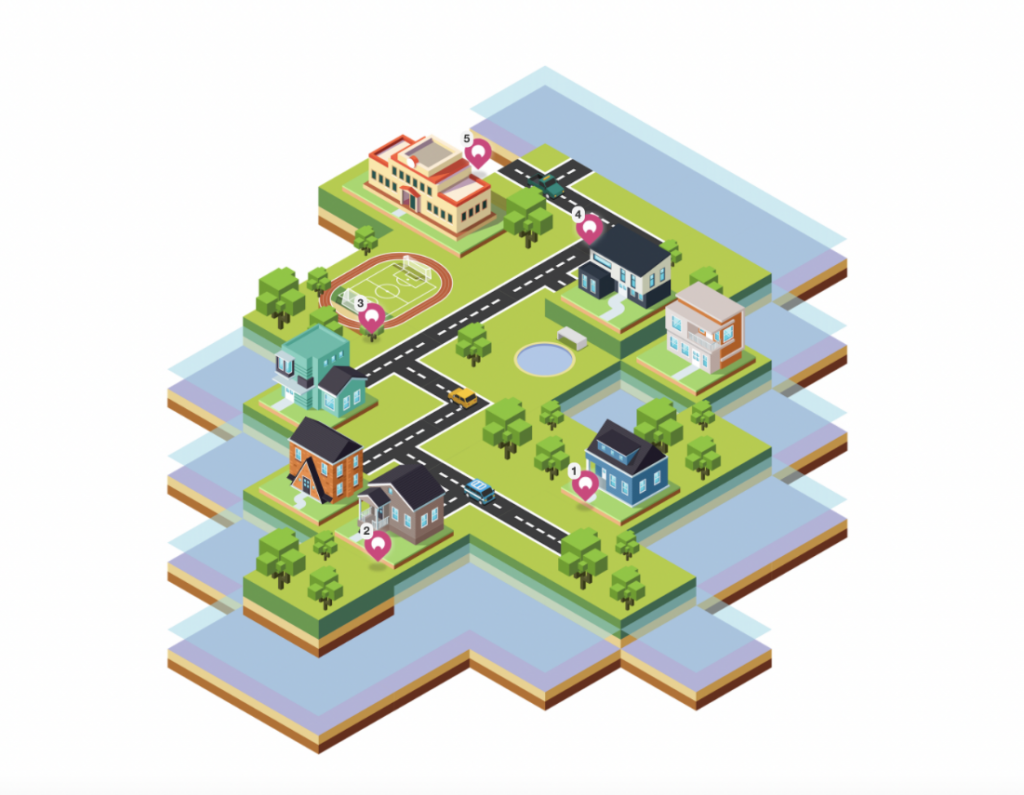Sini Jylhälehto, Jan-Kristian Kurkola & Mikaela Uuksulainen
Planning and tackling new challenges
We participated to the course “Opettaja työnsä tutkijana” (Teacher as a researcher), where we, as home economics teacher students started experimenting with new ways of teaching. In addition to teaching new skills to students, we were able to develop our own teacher identity. Leaving our comfort zone paid off: we learned a tremendous amount of new things of ourselves. Remote teaching brought new perspectives, challenges and experiences of success to the planning, implementation and evaluation. We had a chance to apply hybrid teaching in our experiment: one member of our group was present in the classroom with a group of pupils and the other two were involved remotely via Zoom and Microsoft Teams applications (picture below).
Positioning in class. (Photo: A. Väliahde)
The topic of our teaching experiment was budgeting and practice of grocery shopping. As the importance of consumerism skills is on the grow, wise and responsible use of money is now being considered as an essential part of life management. These themes are also reflected in the curricula of basic education (POPS, 2014). The importance of financial management increases considerably when a young person moves away from home on the threshold of adulthood. Last years of basic education is an important phase between childhood and adulthood because in that period of time, pupils start to take more responsibility gradually about their lives, including financial responsibility. In order to ensure the success of the teaching of consumer education and financial literacy in schools, it is worthwhile to develop teaching methods that are linked to the lives of young people. Examples and stories that reflect real life, make young people identify and think about decisions and their consequences. (Lonka, 2020, s. 24; Oph, n.d.; Peura-Kapanen, 2012, s. 2-3, 6, 9.)
We conducted our teaching experiments for seventh-grade students. We set our own objectives for the smooth implementation of the whole experimentation, in which all three of us would play a concrete role. The teaching experiment put us all in front of something new. From the point of view of teaching and learning, our goal was that through concrete experimenting, students would understand and perceive the value of money and how to spend it wisely. This was the idea we cherished, as creating a platform that would enable students to learn and experiment themselves. The aim was to work together building a learning space that encourages experimentation and to provide a safe environment for “money fails” as well.
We designed our teaching experiments on the basis of a socioconstructive concept of learning. The socioconstructivist concept of learning is based on involving learners in the learning process as active agents in the task at hand and as knowledge editors (POPS, 2014).
The Game
We created a virtual budgeting game on Seppo.io platform. The main character of the game was a fictional young student, Nuppu-Petteri, who had just moved into their own apartment. We wanted to bring the game closer to the students’ own lives and potential future perspectives, which is why we chose a young student as the character.

Game world in Seppo.io gaming platform (Photo: M. Uuksulainen)
In the actual game, Nuppu-Petteri needed help from students to do their monthly budgeting and grocery shopping. The purpose of the budgeting tasks was to guide students to understand where the costs of everyday life come from and how much it might be smart to budget money for food, hygiene supplies and hobbies, for example, just to mention few. The students were also able to consider, whether it would be possible to save money. Once the groups had drawn up the budget that they thought was appropriate, the budget was reflectively discussed, the successful choices made were justified and, if necessary, corrections were made together.
In one of the tasks, the groups were able to distribute the sums of money from their food budget over four weeks of the month and also form a daily food budget. The task allowed us to wonder together, whether the amount felt large, appropriate or small.
One of the tasks combined themes of spending money and grocery shopping. Nuppu-Petteri asked for the students’ help in purchasing the ingredients for their favorite food, chicken soup. The food in question, had been selected for the game based on what the students would prepare later in the lesson. In the assignment, the students had to search the home economics textbook for an instruction on chicken soup and based on it, shop for groceries in the online food store (s-kaupat.fi). The purchases were made fictitiously by taking the products to the shopping cart of the online store. Different student groups made their grocery shopping based on different instructions that we as teachers gave them. Their shopping was supposed to be based either on price (choose the most expensive or the cheapest), favoring domestic products or favoring organic products. This exercise brought more insight to the students about what the price of groceries consist of and what are some of the reasons and behind one’s choices when choosing groceries.
At the end of the game students were asked to respond to self-evaluation questions and give us some feedback on the game. After the game we held a joint discussion of the topics and tasks of the game.
A Pedagogical perspective: a high-quality digital learning platform
Pedagogically high-quality digital learning platform and environment supports community and personalized learning. Learning should enable the experiences of creativity and success. Problem-solving skills can be developed with a functional and exploratory approach that guarantees the role of an active agent for students. (Opetushallitus, 2021.) These were the principles we strived to uphold when we created a learning platform and entity. We wanted to give students space to explore, apply, experiment, misstep and succeed.

Lähteet:
Lonka, K. 2020. Oivaltava oppiminen. 1. verkkoaineisto.
Helsinki: Otava.
Opetushallitus. N.d. S3: Kuluttaja- ja talousosaaminen kodissa.
Saatavilla: https://www.oph.fi/fi/koulutus-ja-tutkinnot/s3-kuluttaja-ja-talousosaaminen-kodissa
Opetushallitus. 2014. Perusopetuksen opetussuunnitelman perusteet. Helsinki: Opetushallitus
Opetushallitus. 2021. Pedagogisesti laadukas digitaalinen ympäristö – Laatumäärittely 2021.
Saatavilla: https://uudetlukutaidot.fi/wp-content/uploads/2021/12/Pedagogisesti-laadukas-digitaalinen-ymparisto.pdf
Peura-Kapanen, L. 2012. Nuorten talousosaamisen edistäminen – Opas toimijoille. Kuluttajatutkimuskeskus: Helsinki.
Saatavilla: https://helda.helsinki.fi/bitstream/handle/10138/152342/Nuorten_talousosaamisen_edistaminen.pdf?sequence=1
